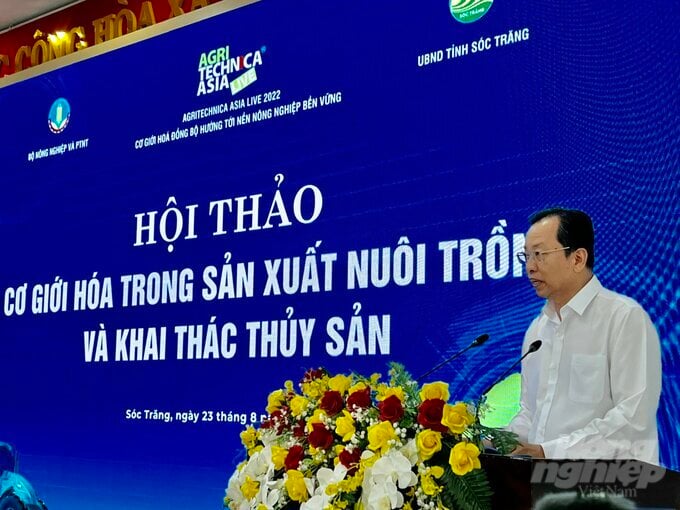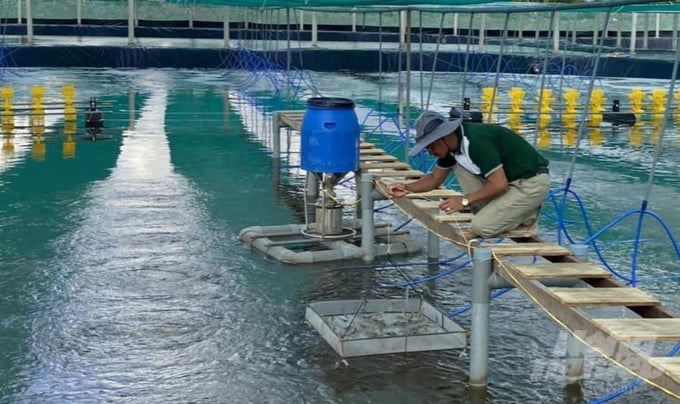November 25, 2025 | 12:40 GMT +7
November 25, 2025 | 12:40 GMT +7
Hotline: 0913.378.918
November 25, 2025 | 12:40 GMT +7
Hotline: 0913.378.918

Vice Chairman of Soc Trang People's Committee Vuong Quoc Nam. Photo: Trong Linh.
On August 23, the Ministry of Agriculture and Rural Development coordinated with the People's Committee of Soc Trang province to organize a workshop on "Mechanization in aquaculture and fishing". This is the second seminar in the agricultural sector’s international series of events "Agritechnica Asia Live 2022" with the theme "Synchronous mechanization towards sustainable agricultural production".
Soc Trang has gradually established large shrimp farming areas in localities through risk-reduction tarpaulin pond models. Mechanization in aquaculture is applied from the initial stages of pond renovation to the harvesting. But facilitation of mechanization in aquaculture requires further improvement in the infrastructure system.
According to a number of businesses and localities in the Mekong Delta region, production, aquaculture, exploitation and processing of fishery products have applied mechanization in almost all stages. For example, in the pond designing stage, farmers use excavators and bulldozers to create new ponds. As for the pond improvement stage, mud scrapers and water pumps are utilized to remove bottom sludge and excess organic matter from the previous crop to prepare for the new crop.

Traces of mechanization in aquaculture can be seen from pond renovation to the harvesting stage. Photo: Trong Linh.
In the shrimp care stage, automatic floor feeding equipment is used to spread the food evenly and reduce labor. Farmers also apply information technology to monitor and reduce feed loos. Environmental factor management and control (pH, temperature, dissolved oxygen) is secured thanks to water quality monitoring equipment and automatic monitoring systems.
Particularly in the multi-stage shrimp rearing model, many large farms now use shrimp auto feeder systems professionally, which is a great solution to reduce stress for postlarvae. Companies also use counting machines to control the exact quantity of shrimp sold.
Regarding mechanization in fishing activities, the most popular method at present is to use winches to drop and collect nets. The crane system has been installed for most fishing vessels with a length of 15m or more. This application results in an increase in productivity, reduced labor requirements and the development of modern fisheries.

Mechanization in aquaculture production and fishing has initially achieved results in each production stage. Photo: Trong Linh.
When it comes to mechanization in production, electricity is an indispensable factor, especially for intensive and super-intensive farming models. Several large shrimp farms have now installed solar power systems, which are showing positive impacts in lessening the shortage of electricity for production.
According to experts, aquaculture in Vietnam and the world has been going through three stages of development. Phase I is traditional aquaculture mainly at a household scale, based on farmers' experience without using machines. Phase II is the transition to mechanization apllication based on mechanical and electrical machinery. Phase III is the era of automatic production where IoT (Internet of things) technology is fully utilized to manage computer software. The software then creates automation features in aquaculture. This stage is known as smart aquaculture.
“Mechanization in aquaculture production and fishing has initially achieved results in each production stage. But looking from the general view, the achievements of mechanization in aquaculture are still quite modest compared to the current context’s actual demands.” Director General of the Directorate of Fisheries Tran Dinh Luan thus stated that the Directorate of Fisheries had made a number of proposals and recommendations to promote mechanization in aquaculture.
The Government needs to remove difficulties related to the Land Law in terms of consolidating and exchanging plots as well as the issues of creating concentrated and large-scale aquaculture production areas in localities. Priority should be given to topics and projects associated with enterprises to facilitate the process of conducting research and supplying equipment for aquaculture. It is also deemed essential to devise a number of pilot projects to apply technology to manage cage farming establishments and key subjects that have been granted identification codes.
Localities should review planning and build large-scale and concentrated aquaculture areas associated with processing and material supplying factories, invest in synchronous infrastructure to create conditions for farming establishments to quickly apply mechanization from production - preservation - processing - transportation to product consumption.
Research units need to focus on applying specific types of machines and equipment for the production, preservation and processing of fishery products to replace imported machinery, ensuring efficiency in models regardless of large or small scale. Specialized organizations should be formed to provide mechanized and automated services at an appropriate price, at the same time sharing information on the positive effects of using automated machinery and systems in aquaculture.
Translated by Samuel Pham

(VAN) Heavy rains make aquatic species more vulnerable to disease. Proactive water management and high-tech systems help farmers prevent outbreaks and protect yields.

(VAN) Greenhouses are shifting production mindsets in Binh Lu commune, enabling farmers to ‘weather the sun and rain’ and secure stable vegetable harvests throughout the year.

(VAN) Green transition is crucial for the Mekong Delta amid climate change and stricter standards, offering a path toward sustainability.

(VAN) Dong Thap promotes agricultural restructuring, forms large specialized farming zones, raises the value of agricultural products and develops toward ecological and high-tech directions.
/2025/11/22/4018-4-213342_747.jpg)
(VAN) The Mekong Delta Agricultural Experts Club has attracted 143 experts and researchers to participate in providing consultancy and contributing initiatives to the development of one million hectares of high-quality rice.

(VAN) Ca Mau’s development of OCOP products opens a path to increasing cooperatives value, helping boost income, expand markets, and affirm collective economy's role.

(VAN) Turning seemingly ordinary coconut shells into unique jewelry and artwork, Nguyen Bang Nhi spreads the value of local culture through her brand, Cocohand.